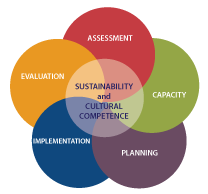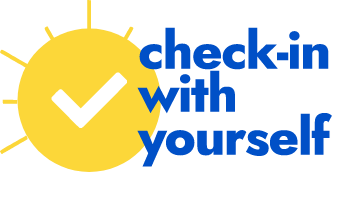Home > PTTC Post Article - February 2023
Author: Cele Fichter-DeSando, MPM
Prevention practitioners use current data and research to collaborate with communities, design programs, deliver services, and evaluate outcomes. Staying up to date with estimates of substance use and mental health indicators and strategies for addressing problems and concerns is critical in providing effective prevention services and achieving positive outcomes. This month’s PTTC Post will focus on the newly released data from the 2021 National Survey on Drug Use and Health (NSDUH) and strategies for developing responsive prevention programs.
In January 2023, the U.S. Department of Health and Human Services’ (HHS) Substance Abuse and Mental Health Services Administration (SAMHSA) released the results of its 2021 annual National Survey on Drug Use and Health (NSDUH). The 2021 NSDUH national report includes selected estimates by race, ethnicity, and age group and shows how people living in America describe their experience with substance use, mental health, and treatment. It is the most comprehensive report on substance use and mental health indicators that SAMHSA has released to date (SAMHSA, 2023.) Prevention professionals are experienced with using past surveys to assess population risks, trends, and the impact of prevention, however, SAMHSA advises that estimates from the 2021 NSDUH should not be compared with estimates from previous years because the COVID-19 pandemic necessitated methodological changes to the data collection process. The key findings can stand alone as indicators of the need for focused prevention and intervention.
Substance Use
Major Depressive Episodes Among Adolescents
Adults and Mental Illness
Co-Occurring Substance Use Disorder with Any Mental Illness
Serious Thoughts of Suicide Plans, and Suicide Attempts
Recovery
Detailed NSDUH Resources
Prevention practitioners do not work in a vacuum set apart from what is happening in the world around them. They use current data and research within the context of specific communities and environments and during specific time-frames and real-world events. In addition to the 2021 NSDUH Key Findings Report, SAMHSA developed Graphics from the Key Findings Report to be used in understanding the data and planning services. These slides and summaries can be used for informing the community and communicating with key groups for the delivery of services.
Perceived Effects of COVID-19 on Substance Use and Mental Health
In the current world situation, it is impossible to design and deliver services without taking into account the effects of COVID-19. The 2021 NSDUH included questions about people's perceptions of how the COVID-19 pandemic affected their lives. These questions asked respondents to describe how the COVID-19 pandemic affected their mental health; substance use; financial security; housing; and access to substance use treatment, mental health services, and medical care. The Substance Use, Mental Health Issues, and the COVID-19 Pandemic
section of the 2021 NSDUH Annual National Report | CBHSQ Data provides estimates of the individual’s perceptions of the effect of the COVID-19 pandemic on substance use and mental health issues. One factor of the impact of COVID-19 of interest to prevention is the concept of loneliness. Community engagement and social connectedness are protective factors that are promoted in evidence-based prevention. A study led by Mareike Ernst, Ph.D., of Johannes Gutenberg-University Mainz in Germany, researched Loneliness Before and During the COVID-19 Pandemic. The study found small increases in loneliness but did not find evidence of a “loneliness pandemic.” The authors recognize that even a small increase in loneliness can have a negative impact. Loneliness is a risk factor associated with premature death and has negative effects on mental and physical health and should be closely monitored as well as a focus of current and future public health efforts (Ernst et al., 2022).
Planning Prevention Programs
To assist prevention professionals in planning comprehensive prevention services strategies with, and for, specific communities and populations, SAMHSA developed the Strategic Prevention Framework (SPF) (SAMHSA 2019.) The SPF consists of 5 steps - assessment, capacity, planning, implementation, and evaluation - and 2 core principles - cultural competence and sustainability
The SPF is used as part of an ongoing process to incorporate new data, risk factors, current public health issues such as COVID-19, and research findings into the prevention planning process.
SPF Resources
 The Prevention Technology Transfer Center (PTTC) Network’s Partnerships for Success developed Webinar Series Resources for SPF to assist organizations in each of the steps and principles of SPF. The resource provides an overview of each of the steps of the SPF and its guiding principles. Included are helpful appendices with further information on the Assessment, Capacity, Planning, Implementation, and Evaluation steps.
The Prevention Technology Transfer Center (PTTC) Network’s Partnerships for Success developed Webinar Series Resources for SPF to assist organizations in each of the steps and principles of SPF. The resource provides an overview of each of the steps of the SPF and its guiding principles. Included are helpful appendices with further information on the Assessment, Capacity, Planning, Implementation, and Evaluation steps.
A new resource developed by the Great Lakes PTTC Selecting Prevention Strategies at Work consists of a toolkit and PowerPoint presentation to walk prevention practitioners and coalition members through prioritizing risk and protective factors and selecting an evidence-based strategy as part of the planning step of the SPF. The toolkit has 5 worksheets to assist with the planning process: Risk and Protective Factor Prioritization, Potential Strategies, Strategy Description, Strategy Assessment, and Strategy Prioritization.
Checking in with Other Prevention Programs
 In addition to staying current with new research findings and prevention resources, learning about prevention programs established in other regions can provide information and resources for the development of new programs and the expansion of existing programs. A new program currently funded by the Washington State Health Care Authority and conducted by the University of Washington is the Check-in with Yourself Program.
In addition to staying current with new research findings and prevention resources, learning about prevention programs established in other regions can provide information and resources for the development of new programs and the expansion of existing programs. A new program currently funded by the Washington State Health Care Authority and conducted by the University of Washington is the Check-in with Yourself Program.
Check-in-with-Yourself is a free online program for 18-29-year-olds in Washington State. It provides tailored information designed to promote reflection on feelings, learn coping strategies, and improve health and well-being. The program is anonymous and can be accessed 24/7 from any device with an internet browser. The Check in with Yourself Tool has 5 modules with personalized feedback on:
The tool was designed by behavioral health experts at the Center for the Study of Health and Risk Behaviors and the Department of Psychiatry and Behavioral Sciences at the University of Washington and is meant to be a private, personal, self-check-in for young adults ages 18-29 in Washington.
For more information on Check-in with Yourself contact:
CHRISTINE LEE, PH.D.
Research Professor, Psychiatry and Behavioral Sciences
Associate Director, Center for the Study of Health and Risk Behaviors
Box 357238 / Seattle, WA / 98195
[email protected]
References
Ernst, M., Niederer, D., Werner, A. M., Czaja, S. J., Mikton, C., Ong, A. D., Rosen, T., Brähler, E., & Beutel, M. E. (2022). Loneliness before and during the COVID-19 pandemic: A systematic review with meta-analysis. The American psychologist, 77(5), 660–677. https://doi.org/10.1037/amp0001005
Great Lakes, Prevention Technology Transfer Center, 2023. Selecting Prevention Strategies that Work. Publication Date: January 5, 2023. Great Lakes PTTC.
https://pttcnetwork.org/centers/great-lakes-pttc/product/selecting-prevention-strategies-work
Partnerships for Success, Prevention Technology Transfer Center Network 2020. The Partnerships for Success Academy 2020 webinar series. Strategic Prevention Framework Resources. https://pttcnetwork.org/centers/mid-america-pttc/partnerships-success-pfs
Substance Abuse and Mental Health Services Administration. (2022). Key substance use and mental health indicators in the United States: Results from the 2021 National Survey on Drug Use and Health (HHS Publication No. PEP22-07-01-005, NSDUH Series H-57). Center for Behavioral Health Statistics and Quality, Substance Abuse and Mental Health Services Administration. https://www.samhsa.gov/data/report/2021-nsduh-annual-national-report
Substance Use and Mental Health Services Administration. (2022). Results from the 2021 National Survey on Drug Use and Health Graphics from the Key Findings Report. Center for Behavioral Health Statistics and Quality, Substance Abuse and Mental Health Services Administration. 2022.
Results from the 2021 National Survey on Drug Use and Health: Graphics from the Key Findings Report | SAMHSA
Substance Use and Mental Health Services Administration (SAMHSA), (2023). 2021 National Survey of Drug Use and Health (NSDUH) Releases. SAMHSA January 4, 2023.
SAMHSA Announces National Survey on Drug Use and Health (NSDUH) Results Detailing Mental Illness and Substance Use Levels in 2021
Substance Abuse and Mental Health Services Administration: A Guide to SAMHSA's Strategic Prevention Framework. Rockville, MD: Center for Substance Abuse Prevention. Substance Abuse and Mental Health Services Administration, 2019.